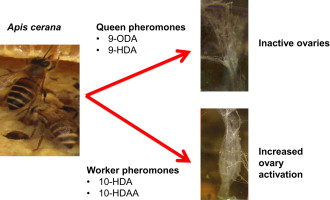
Queen Mandibular Pheromone (QMP) is a group of (at least) five active compounds produced by queen honey bees. The pheromone aids in queen control of the colony and colony cohesion. The effects of individual QMP components have never been tested to determine their effects on the reproductive physiology of Apis cerana workers.
Prof. TAN Ken of Xishuangbanna Tropical Botanical Garden (XTBG) of Chinese Academy of Sciences and his colleagues conducted a study to provide groups of queenless A. cerana workers with individual QMP components in their food and determine which of the components are capable of suppressing ovary activation.
The researchers fed one queen equivalent of each of the major components of A. cerana QMP to groups of c.a. 500 day-old, caged, workers twice a day until the workers were 10 days old. Half of the cages were also provided with 10% royal jelly in the food. Workers were sampled each day and dissected to determine the number of ovarioles and the degree of ovary activation (egg development).
Using maximum likelihood, the researchers analyzed data by fitting generalized linear models. They fitted the independent variables as bee age (1–10 days), pheromone treatment (9-ODA, 9-HDA, HOB, 10-HDA, 10-HDAA or the mixture), presence or absence of royal jelly and cage nested within pheromone by royal jelly combination. The dependent variables were ovary activation score or ovariole number.
The study showed that the major components of the queen mandibular secretions 9-ODA (9-oxo-2-decenoic acid) and 9-HAD (9-hydroxy-(E)-2-decenoic acid) that are common to A. cerana and A. mellifera strongly inhibit worker ovary activation in young A. cerana workers. The minor components, 10-HAD (10-hydroxy-2-decenoic acid) and 10-HDAA (10-Hydroxydecanoic acid) have minimal effects on ovary activation. Royal jelly enhances ovary activation, but ovary activation is still strongly suppressed by 9-ODA and 9-HDA in bees that have access to royal jelly.
The ovariole number declines with age, and declines to a greater extent in the absence of queen-associated fatty acids. The queen pheromones inhibit decline in ovariole number over the first 10 days of life. This suggests that ovary activation itself causes a decline in ovariole number, or that loss of ovarioles is required for ovary activation in queenless workers.
The results show that 9-ODA alone suppresses ovary activation to a similar or greater degree than it does in a mixture of all compounds. It therefore appears that 9-ODA is the primary signal that mediates worker fertility in A. cerana.
The study entitled “Pheromones affecting ovary activation and ovariole loss in the Asian honey bee Apis cerana” has been published on Journal of Insect Physiology.


86-10-68597521 (day)
86-10-68597289 (night)

52 Sanlihe Rd., Xicheng District,
Beijing, China (100864)

